EscapedAritst
New Member
I finally pulled the trigger. I just purchased a system...my first! This is the spec:
- 4 EG4 48v 6500 inverters for split phase off-grid application
- 6 EG4 batteries (to be doubled after systems up and running and tested)
- 36 panels of 450 watt panels (not important but comments welcomed)
And now I'm planning the wiring. When I read the PDF from FilterGuy called "Calculating Inverter Wire Size.pdf", I calculate the following:
( 6500w / .9 (efficiency) / 48v ) * 1.25 = 188 amps per inverter. I can position the batteries near the inverters so I am planning on the longest cable being 2m.
On Will's wiring diagram for a similar system, I see he has protected each inverter with a 200amp T class fuse. This is inline with my calculation above. BUT, when I use FilterGuy's wire size chart, I see the wire size for a 200amp fuse at 90deg C is 2AWG, Will is using 2/0 wire, and when I look up on a wire size calculator (www.southwire.com), I get 3/0 required. So, the first question is what is the discrepancy and how do I make an informed decision? FilterGuy puts an example in his PDF with an inverter he calculates a 180amp draw (24V 3000W inverter with 90%) and he uses 1AWG cable for safety but says a 2AWG would work.
Even more alarming is that Will connects two parallel inverters (I am assuming that will double the amperage? No??) but has a 300amp busbar feeding these two inverters and only a 4/0 cable feeding from one of his battery banks. My wire size calculator requires multiple cables when the amps go up to 360.
And finally, because I'm going to be connecting 4 of these inverters but having just one battery bank feeding them, it seems like no sized single cable could handle 752amps (that is 4 inverters times 188amps each). I don't even think the busbar of my battery case will support this.
Knowing that you can stack 6 of these inverters, I know I must be missing something really basic.
Thanks!
- 4 EG4 48v 6500 inverters for split phase off-grid application
- 6 EG4 batteries (to be doubled after systems up and running and tested)
- 36 panels of 450 watt panels (not important but comments welcomed)
And now I'm planning the wiring. When I read the PDF from FilterGuy called "Calculating Inverter Wire Size.pdf", I calculate the following:
( 6500w / .9 (efficiency) / 48v ) * 1.25 = 188 amps per inverter. I can position the batteries near the inverters so I am planning on the longest cable being 2m.
On Will's wiring diagram for a similar system, I see he has protected each inverter with a 200amp T class fuse. This is inline with my calculation above. BUT, when I use FilterGuy's wire size chart, I see the wire size for a 200amp fuse at 90deg C is 2AWG, Will is using 2/0 wire, and when I look up on a wire size calculator (www.southwire.com), I get 3/0 required. So, the first question is what is the discrepancy and how do I make an informed decision? FilterGuy puts an example in his PDF with an inverter he calculates a 180amp draw (24V 3000W inverter with 90%) and he uses 1AWG cable for safety but says a 2AWG would work.
Even more alarming is that Will connects two parallel inverters (I am assuming that will double the amperage? No??) but has a 300amp busbar feeding these two inverters and only a 4/0 cable feeding from one of his battery banks. My wire size calculator requires multiple cables when the amps go up to 360.
And finally, because I'm going to be connecting 4 of these inverters but having just one battery bank feeding them, it seems like no sized single cable could handle 752amps (that is 4 inverters times 188amps each). I don't even think the busbar of my battery case will support this.
Knowing that you can stack 6 of these inverters, I know I must be missing something really basic.
Thanks!





